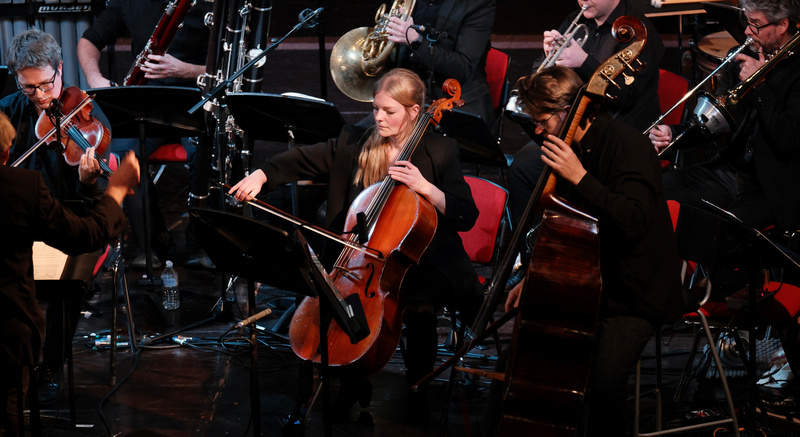
Huddersfield Contemporary Music Festival. Music. There were times during my long weekend at this year’s HCMF when i had to keep reminding myself of this word. Performance art, and works incorporating dramatic and theatrical elements, are not just a staple of new music festivals, they’ve become in many cases tentpole events, designed to showcase the festival’s credentials as a bona fide “cutting edge” experience. There’s nothing remotely problematic about this, of course, though what i find increasingly troubling is the extent to which the overwhelming weight of creative attention – and with it the sophistication, subtlety and nuance – is placed on the works’ visual elements, such that the musical aspect becomes sidelined and even trivialised.
Hitherto, i haven’t particularly regarded this as a problem in Jennifer Walshe‘s work, but it certainly was in her latest offering, PERSONHOOD, given its UK première by the Oslo Sinfonietta on the opening night of the festival. The primary stumbling block in many of Walshe’s multimedia extravaganzas of recent years is the way she so often diffuses the focus of her subject matter. The result, though not a stream of consciousness, is akin to the experience of a psychoanalytic psychotherapy session, pulling at threads somewhat arbitrarily, leaving the audience to piece together real or contrived connections between its meme-like references. And so it was with PERSONHOOD, a 50-minute pop cultural farrago centred on accordionist Andreas Borregaard, who spent most of the time away from his instrument taking on assorted roles with varying levels of agency. It’s impossible not to be entertained by Walshe’s work, but it became increasingly apparent just how empty and reactive was the aural dimension of the work, with the Oslo Sinfonietta reduced to basic textural atmospherics and treading water, only occasionally rising up to exert some dominance. At times PERSONHOOD was modestly entertaining, but it all felt much more superficial and inconsequential than previously.
To some degree the same could be said, regarding music, of Laura Bowler‘s ADVERT, premièred by Bowler alongside Decoder Ensemble. i’ve written in the past about the way the subject matter of Bowler’s output tends either to be universal (Antarctica; Distance) or acutely personal (FFF; The Blue Woman), and ADVERT falls emphatically into the latter category. In contrast to Walshe, it’s usually impossible to be entertained by Bowler’s work simply because of the weight of its highly-charged subject matter (which is obviously no bad thing). In this performance it was immediately evident that we were being plunged into a maelstrom of deeply personal reflections, admissions and considerations that, at times, made for a distinctly troubling experience. Yet militating against this, in the same way as Walshe, was the banality of its soundworld, which in tandem with the rather sprawling nature of its content, had the result of diminishing ADVERT into a relentless, punchy (literally, during one boxing sequence) litany of the quotidian and the quizzical. Furthermore, it was a real shame that throughout so much of the performance Bowler’s words were barely audible, though this was almost entirely due to the boring, blank callithumpian belligerence of the music. It’s disappointing to report that here too was a performance overwhelmingly focused on the visual at the expense of the aural, and the most uncomfortable aspect of all was witnessing such excruciatingly personal stuff being laid bare in such an incoherent and ultimately ineffectual context.

Though it didn’t have a visual component – music qua music! – Øyvind Torvund‘s Into the Blue was about as visual as it was possible for a purely aural piece to be. Performed by the Oslo Sinfonietta (who now had very much more to do), conducted by Christian Eggen, the work was suffused with technicolor warmth and a shining filmic gloss. It tapped into archetypes of light music prettiness, avoiding kitsch in favour of something more elusively referential. Its soundworld was messy but intoxicating, broken up with halting and chatty pointillist figurations, or blurred as if captured through a haze, and at one point apparently coming off the rails completely. Yet the lack of directness only made what lay beneath seem more and more transparent, conjuring up a balmy, dreamy form of glamour that Torvund only allowed to properly expand towards the end, coloured by swooping synth glisses amid the restrained florid heat of the ensemble. It was genuinely lovely to experience such a quiet homage – even a paean – to extant music that, though often askew, avoided all hints of postmodern sarcasm and irony.

In the same concert, at the opposite end of the spectrum from Torvund’s surface glamour, was Rebecca Saunders‘ Skull, which forms the final part of a triptych preceded by Scar and Skin. Now we were transported to a similarly halting but altogether more troubling environment, a place of bitesize lyrical moments, the ensemble mutually sympathetic yet with an unstable kind of counterpoint, seemingly becoming more expansive yet continually returning to zero. Its tone, as so often in Saunders’ work, was both immediate yet uncertain: was it too simplistic to hear it as mournful? If anything (and this is perhaps an association i should have made years ago) it brought to mind the intense merging of pleasure and pain of Clive Barker’s Hellraiser mythos, the Oslo Sinfonietta unleashing a stunning, desperate and at times agonised song comprised of a chorus of calling, keening, roiling and moaning – precisely the kind of exquisite pain enacted by Barker’s cenobites. Despite the potency of its sonic torment, at 35 minutes’ duration Skull nonetheless suffered from sounding overlong, due to how very well-defined (even confined) were the limits of its language and vocabulary, beyond which the music never ventured. Yet in hindsight, even this seemed to reinforce the dark, charming malevolence at the work’s core. Saunders’ work often disquiets, but Skull did this more than most.
